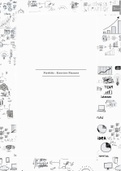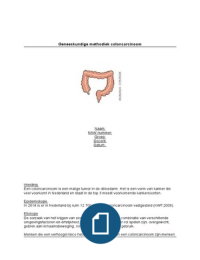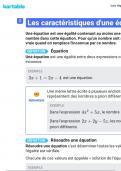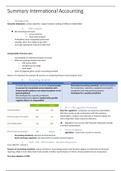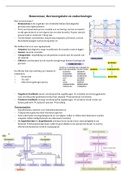MARKETING COMMUNICATION
SUMMARY LECTURES, COMPULSORY PAPERS, AND BOOK CHAPTERS
(3, 4, 6, 12).
Inhoudsopgave
week 1.......................................................................................................... 3
“what holds attention? linguistic drivers of engagement. Berger j., moe w. w. &
schweidel d.a. (p. 793-796)............................................................................................3
lecture 1: introduction.................................................................................................... 3
week 2.......................................................................................................... 4
session 1: breaking through the advertising clutter........................................................4
how campaigns can stand out: attracting attention.....................................................4
how campaigns can stand out: sustaining attention....................................................6
lecture 2: persuasion...................................................................................................... 7
persuasion, attitudes and attitude functions................................................................7
persuasion & advertising repetition.............................................................................8
resistance to persuasion.............................................................................................. 9
persuasion: a dual system approach..........................................................................10
influencing the route to persuasion...........................................................................12
“ad wearout wearout: how time can reverse the negative effect of frequent advertising
repetition on brand preference.” krondrod a. & huber j. (306-308, 310-313)...............12
“advertising repetition as a signal of quality: if it’s advertised so mouch, something
must be wrong.” kirmani a. (77-86)..............................................................................13
“when web pages influence choice: effects of visual primes on experts and novices.”
mandel n. & johnson e.j. (234-242)...............................................................................13
“central and peripheral routes to advertising effectiveness: the moderating role of
involvement.” petty r.e., cacioppo j.t. & schumann d. (138-144)..................................15
week 3........................................................................................................ 17
lecture 3: affective persuasion.....................................................................................17
affect......................................................................................................................... 17
affective persuasion................................................................................................... 19
affect regulation........................................................................................................ 19
“offline context affects online reviews: the effect of post-consumption weather”,
Brandes l. & dover y..................................................................................................... 20
“MAKING products feel special: when metacognitive difficulty enhances evaluation.”
pocheptsova a., labroo a.a. & dhar r.............................................................................20
,week 4........................................................................................................ 21
lecture 4: nudging........................................................................................................ 22
influence and behavioral economics..........................................................................22
four heuristics from behavioral economics................................................................22
confirmation bias and status quo...............................................................................24
“nudging app adoption: choice architecture facilitates consumer uptake of mobile
apps.” reeck c., posner n.a., mrkva k. & johnson e.j.....................................................24
“there are many reasons to drive a bmw: does imagined ease of argument generation
influence attitudes?” wanke m., bohner g. & jurkowitsch a..........................................25
“consumer learning: advertising and the ambiguity of product experience.” hoch s.j. &
ha y.w........................................................................................................................... 26
week 5........................................................................................................ 27
lecture 5: social influence............................................................................................. 27
social networks: who to influence?............................................................................27
social motives: why people rely on others?................................................................27
why people share information (WOM)........................................................................29
endorsements: celebrities vs. influencers..................................................................30
“when demand accelerates demand: trailing the bandwagon.” van herpen e., pieters r.
& zeelenberg m............................................................................................................ 30
“social influences in the digital era: when do people conform more to a human being or
an artificial intelligence?” riva p. aureli n. & silvestrini f...............................................32
“celebrity vs. influencer endorsements in advertising: the role of identification,
credibility, and product-endorser fit.” schouten a. p., janssen l. & verspaget m...........33
week 6........................................................................................................ 34
lecture 6: issues in media planning..............................................................................34
advertising in a changing media landscape...............................................................34
context effects........................................................................................................... 35
commercial context effects........................................................................................ 36
editorial context effects.............................................................................................36
“breaking through fast-forwarding: brand information and visual attention.” brasel s.a.
& gips j......................................................................................................................... 37
“the effects of contextual priming in print advertisements.” yi y. (215-216)................39
“the influence of media multitasking on advertising effectiveness.” garaus m............40
practice exam questions..............................................................................42
,WEEK 1
“WHAT HOLDS ATTENTION? LINGUISTIC DRIVERS OF ENGAGEMENT.
BERGER J., MOE W. W. & SCHWEIDEL D.A. (P. 793-796)
Everyone wants to hold their audience’s attention, but not all content holds attention.
Language that is easier to process encourages continued reading, as does language that
evokes emotions. These effects are driven by the degree to which different discrete
emotions evoke arousal and uncertainty. Anxious, exciting and hopeful language all
encourage reading, while sad language discourages it. Findings make four main
contributions:
- Deepen understanding around what holds attention.
- Help improve content design.
- Results highlight that what holds attention is not always the same as what grabs
attention or encourages word of mouth.
Ex. Certainty attracts but does not sustain attention.
- Important societal implications – if angry and anxious holds attention, algorithms
may recommend this.
Beyond whether an article, advertisement, or other piece of content attracts attention,
sustaining attention refers to whether that content holds attention. Holding attention
involves retaining the attracted attention, keeping audiences engaged. Holding attention
deepens brand relationships, encourages learning, and drives purchase and choice.
Social acceptance motives shape what people share, as does interpersonal closeness.
Products that are more visible or triggered more by the environment are talked about
more. This like shares affect diffusion, but they do not say much about content
consumption.
People will be more engaged in topics they find personally interesting. Suggested is that
processing ease and emotional language are two key factors that sustain attention:
- Processing ease -> how much cognitive effort text requires to process. Suggested
is that textual features that make content easier to process should have positive
effects on sustained attention and continued consumption. The easier, the more
do it. Texts should be short, familiar, and concrete.
- Emotional language -> can increase attention or flag that something is important
and deserves further consideration. Suggested is that whether emotional
language sustains attention depends on the link between specific emotions,
uncertainty, and arousal.
o Uncertainty can increase attention and processing as people try to resolve
what will happen, it should hold attention and encourage content
consumption.
o Arousal is a state of being physiologically alert, awake, and attentive.
Suggested is that language related to high-arousal emotions should
sustain attention and encourage continued consumption. Arousal ->
vigilance: helps hold attention.
LECTURE 1: INTRODUCTION.
, WEEK 2
SESSION 1: BREAKING THROUGH THE ADVERTISING CLUTTER.
Attention =
- Limited.
- Selective.
- Voluntary (understand what is happening)/involuntary (unconscious attraction to
something).
- Prediction for further
processing.
Levels of processing/involvement:
- Pre-attention: little or no capacity required (automatic processing)
- Focal attention: little capacity required.
- Comprehension: modest levels of capacity required.
- Elaboration: substantial levels of capacity required.
Levels of audience
involvement ~
information processing
stages.
HOW CAMPAIGNS CAN STAND OUT: ATTRACTING ATTENTION
INCREASING INVOLUNTARY ATTENTION
Often unconscious and involuntary: “attractors”: Bottom-up processing:
- Saliency ~ salient, original, and novel stimuli.
SUMMARY LECTURES, COMPULSORY PAPERS, AND BOOK CHAPTERS
(3, 4, 6, 12).
Inhoudsopgave
week 1.......................................................................................................... 3
“what holds attention? linguistic drivers of engagement. Berger j., moe w. w. &
schweidel d.a. (p. 793-796)............................................................................................3
lecture 1: introduction.................................................................................................... 3
week 2.......................................................................................................... 4
session 1: breaking through the advertising clutter........................................................4
how campaigns can stand out: attracting attention.....................................................4
how campaigns can stand out: sustaining attention....................................................6
lecture 2: persuasion...................................................................................................... 7
persuasion, attitudes and attitude functions................................................................7
persuasion & advertising repetition.............................................................................8
resistance to persuasion.............................................................................................. 9
persuasion: a dual system approach..........................................................................10
influencing the route to persuasion...........................................................................12
“ad wearout wearout: how time can reverse the negative effect of frequent advertising
repetition on brand preference.” krondrod a. & huber j. (306-308, 310-313)...............12
“advertising repetition as a signal of quality: if it’s advertised so mouch, something
must be wrong.” kirmani a. (77-86)..............................................................................13
“when web pages influence choice: effects of visual primes on experts and novices.”
mandel n. & johnson e.j. (234-242)...............................................................................13
“central and peripheral routes to advertising effectiveness: the moderating role of
involvement.” petty r.e., cacioppo j.t. & schumann d. (138-144)..................................15
week 3........................................................................................................ 17
lecture 3: affective persuasion.....................................................................................17
affect......................................................................................................................... 17
affective persuasion................................................................................................... 19
affect regulation........................................................................................................ 19
“offline context affects online reviews: the effect of post-consumption weather”,
Brandes l. & dover y..................................................................................................... 20
“MAKING products feel special: when metacognitive difficulty enhances evaluation.”
pocheptsova a., labroo a.a. & dhar r.............................................................................20
,week 4........................................................................................................ 21
lecture 4: nudging........................................................................................................ 22
influence and behavioral economics..........................................................................22
four heuristics from behavioral economics................................................................22
confirmation bias and status quo...............................................................................24
“nudging app adoption: choice architecture facilitates consumer uptake of mobile
apps.” reeck c., posner n.a., mrkva k. & johnson e.j.....................................................24
“there are many reasons to drive a bmw: does imagined ease of argument generation
influence attitudes?” wanke m., bohner g. & jurkowitsch a..........................................25
“consumer learning: advertising and the ambiguity of product experience.” hoch s.j. &
ha y.w........................................................................................................................... 26
week 5........................................................................................................ 27
lecture 5: social influence............................................................................................. 27
social networks: who to influence?............................................................................27
social motives: why people rely on others?................................................................27
why people share information (WOM)........................................................................29
endorsements: celebrities vs. influencers..................................................................30
“when demand accelerates demand: trailing the bandwagon.” van herpen e., pieters r.
& zeelenberg m............................................................................................................ 30
“social influences in the digital era: when do people conform more to a human being or
an artificial intelligence?” riva p. aureli n. & silvestrini f...............................................32
“celebrity vs. influencer endorsements in advertising: the role of identification,
credibility, and product-endorser fit.” schouten a. p., janssen l. & verspaget m...........33
week 6........................................................................................................ 34
lecture 6: issues in media planning..............................................................................34
advertising in a changing media landscape...............................................................34
context effects........................................................................................................... 35
commercial context effects........................................................................................ 36
editorial context effects.............................................................................................36
“breaking through fast-forwarding: brand information and visual attention.” brasel s.a.
& gips j......................................................................................................................... 37
“the effects of contextual priming in print advertisements.” yi y. (215-216)................39
“the influence of media multitasking on advertising effectiveness.” garaus m............40
practice exam questions..............................................................................42
,WEEK 1
“WHAT HOLDS ATTENTION? LINGUISTIC DRIVERS OF ENGAGEMENT.
BERGER J., MOE W. W. & SCHWEIDEL D.A. (P. 793-796)
Everyone wants to hold their audience’s attention, but not all content holds attention.
Language that is easier to process encourages continued reading, as does language that
evokes emotions. These effects are driven by the degree to which different discrete
emotions evoke arousal and uncertainty. Anxious, exciting and hopeful language all
encourage reading, while sad language discourages it. Findings make four main
contributions:
- Deepen understanding around what holds attention.
- Help improve content design.
- Results highlight that what holds attention is not always the same as what grabs
attention or encourages word of mouth.
Ex. Certainty attracts but does not sustain attention.
- Important societal implications – if angry and anxious holds attention, algorithms
may recommend this.
Beyond whether an article, advertisement, or other piece of content attracts attention,
sustaining attention refers to whether that content holds attention. Holding attention
involves retaining the attracted attention, keeping audiences engaged. Holding attention
deepens brand relationships, encourages learning, and drives purchase and choice.
Social acceptance motives shape what people share, as does interpersonal closeness.
Products that are more visible or triggered more by the environment are talked about
more. This like shares affect diffusion, but they do not say much about content
consumption.
People will be more engaged in topics they find personally interesting. Suggested is that
processing ease and emotional language are two key factors that sustain attention:
- Processing ease -> how much cognitive effort text requires to process. Suggested
is that textual features that make content easier to process should have positive
effects on sustained attention and continued consumption. The easier, the more
do it. Texts should be short, familiar, and concrete.
- Emotional language -> can increase attention or flag that something is important
and deserves further consideration. Suggested is that whether emotional
language sustains attention depends on the link between specific emotions,
uncertainty, and arousal.
o Uncertainty can increase attention and processing as people try to resolve
what will happen, it should hold attention and encourage content
consumption.
o Arousal is a state of being physiologically alert, awake, and attentive.
Suggested is that language related to high-arousal emotions should
sustain attention and encourage continued consumption. Arousal ->
vigilance: helps hold attention.
LECTURE 1: INTRODUCTION.
, WEEK 2
SESSION 1: BREAKING THROUGH THE ADVERTISING CLUTTER.
Attention =
- Limited.
- Selective.
- Voluntary (understand what is happening)/involuntary (unconscious attraction to
something).
- Prediction for further
processing.
Levels of processing/involvement:
- Pre-attention: little or no capacity required (automatic processing)
- Focal attention: little capacity required.
- Comprehension: modest levels of capacity required.
- Elaboration: substantial levels of capacity required.
Levels of audience
involvement ~
information processing
stages.
HOW CAMPAIGNS CAN STAND OUT: ATTRACTING ATTENTION
INCREASING INVOLUNTARY ATTENTION
Often unconscious and involuntary: “attractors”: Bottom-up processing:
- Saliency ~ salient, original, and novel stimuli.


